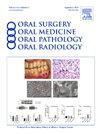Intraosseous mandibular clear cell odontogenic carcinoma with predominant small round blue cells: a potential diagnostic pitfall
IF 2
3区 医学
Q2 DENTISTRY, ORAL SURGERY & MEDICINE
Oral Surgery Oral Medicine Oral Pathology Oral Radiology
Pub Date : 2024-08-05
DOI:10.1016/j.oooo.2024.07.009
引用次数: 0
Abstract
Objective
Clear cell odontogenic carcinoma (CCOC) is a rare malignancy of the jaw, presenting significant diagnostic challenges. This report aims to highlight the complexities associated with biopsy-based diagnoses of oral and maxillofacial lesions, as demonstrated in a case of intraosseous mandibular CCOC initially suggestive of Ewing's sarcoma due to its presentation with small round blue cells.
Results
The patient, a 37-year-old male, presented with a mandibular lesion that on incisional biopsy was suggestive of Ewing's sarcoma. Subsequent, comprehensive histologic evaluation after definitive resection via mandibulectomy revealed a CCOC, characterized by a biphasic pattern of clear and basaloid cells. Histological examination confirmed the presence of glycogen-rich clear cells, supported by periodic acid-Schiff (PAS) staining and confirmed by PAS diastase staining, which demonstrated glycogen digestion. Immunohistochemistry was positive for AE1/AE3, p40, and p63, while negative for c-kit and CD34, confirming CCOC and excluding other malignancies such as Ewing's sarcoma, which would have been treated with neoadjuvant chemotherapy instead of primary surgical treatment as in CCOC.
Conclusion
This case highlights the essential need for thorough histopathological evaluation and the value of a second opinion via additional histologic consultation, particularly due to the diagnostic challenges of heterogeneous lesions in the oral and maxillofacial region.
以小圆形蓝细胞为主的下颌骨透明细胞牙源性癌:潜在的诊断陷阱。
目的:透明细胞牙源性癌(CCOC)是一种罕见的颌骨恶性肿瘤,给诊断带来了巨大挑战。本报告旨在强调口腔颌面部病变活检诊断的复杂性,一例下颌骨骨内透明细胞牙原性癌因其表现为蓝色小圆形细胞,最初被认为是尤文氏肉瘤:患者是一名37岁的男性,他的下颌骨病变在切开活检时提示为尤文氏肉瘤。通过下颌骨切除术进行明确切除后,进行了全面的组织学评估,发现这是一种CCOC,其特征是透明细胞和基底细胞的双相模式。组织学检查证实了富含糖原的透明细胞的存在,周期性酸-Schiff(PAS)染色证实了这一点,PAS diastase 染色也证实了这一点,该染色显示了糖原消化。免疫组化结果显示,AE1/AE3、p40和p63阳性,而c-kit和CD34阴性,证实为CCOC,并排除了尤文氏肉瘤等其他恶性肿瘤:本病例强调了进行全面组织病理学评估的必要性,以及通过组织学会诊获得第二意见的价值,特别是由于口腔颌面部异质性病变的诊断难题。
本文章由计算机程序翻译,如有差异,请以英文原文为准。
求助全文
约1分钟内获得全文
求助全文
来源期刊

Oral Surgery Oral Medicine Oral Pathology Oral Radiology
DENTISTRY, ORAL SURGERY & MEDICINE-
CiteScore
3.80
自引率
6.90%
发文量
1217
审稿时长
2-4 weeks
期刊介绍:
Oral Surgery, Oral Medicine, Oral Pathology and Oral Radiology is required reading for anyone in the fields of oral surgery, oral medicine, oral pathology, oral radiology or advanced general practice dentistry. It is the only major dental journal that provides a practical and complete overview of the medical and surgical techniques of dental practice in four areas. Topics covered include such current issues as dental implants, treatment of HIV-infected patients, and evaluation and treatment of TMJ disorders. The official publication for nine societies, the Journal is recommended for initial purchase in the Brandon Hill study, Selected List of Books and Journals for the Small Medical Library.
 求助内容:
求助内容: 应助结果提醒方式:
应助结果提醒方式:


